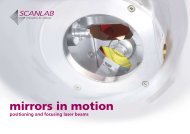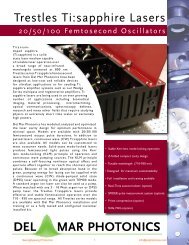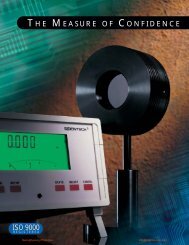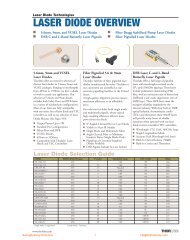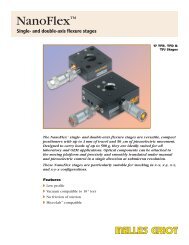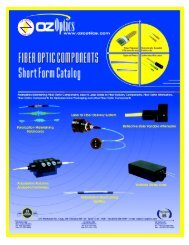DPSS Laser - 성경 포토닉스
DPSS Laser - 성경 포토닉스
DPSS Laser - 성경 포토닉스
- No tags were found...
Create successful ePaper yourself
Turn your PDF publications into a flip-book with our unique Google optimized e-Paper software.
PCEdu-1Photon Counting Fundamentals Educator PackDegree Level Training in PhotonCounting FundamentalsSensL’s PCEdu-1 Photon Counting Fundamentals EducatorPack is an entry level lecture and laboratory series providingthe ideal solution for academics looking to launch a low lightsensing or semiconductor device physics training module. It’salso perfect for OEMs looking to quickly come up the learningcurve on the technologies associated with photon counting andlow light sensing. The pack contains a range of tools and documentationthat will bring the user through a number of steps,from the basic theory of photon counting and photodetection toapplication examples that depend on photon counting. Thestructured and detailed application notes combined with abroad range of instrumentation is the complete tutorial packagefor anyone looking to quickly engage in the exciting worldof photon counting.Theory and Lecture NotesThe comprehensive and structured series of lecture notes takethe trainee through six modules, each with specific learning objectivesthat prepare the trainee for the practical labs that follow.The major topics covered are:• Module 1: Basic semiconductor device physics• Module 2: Photodiode operation• Module 3: Photodiode characterization• Module 4: Noise in photodiodes• Module 5: Photon counting• Module 6: Quenching fundamentalsFor further details on the topics covered, see Page 2.Interactive Labs and ExperimentsComplementing the theory modules are five lab sessionsdesigned to evaluate and confirm the theories of photodiodeoperation and photon counting. With detailed illustration andstep by step instructions the lab sessions enable the traineeto gain a first-hand experience of working with real productionquality photon counting and low light sensing devices.The concepts evaluated include:• Lab 1: Investigate the three modes of photodiode operation• Lab 2: Photodiode I-V characteristics and dark count rate• Lab 3: Photon detection probability• Lab 4: Passive quench circuit simulation• Lab 5: Passive vs. active quench characteristicsFor further details on the experiments conducted, see Page 3.Included Hardware and SoftwareAll items necessary to perform a range of experiments to familiarizethe participant in the area of Photon Counting:• SensL Miniature Photon Counter• SensL PQC - Passive Quench Circuit• Calibrated reference detector• White light source• Integrating sphere• Range of neutral density filters• Range of optical bandpass filters• Leads, connectors, and power supply cables• Manual and application notes• Installation CD with SensL Integrated Environment (SIE)software• SiMetrix Circuit Simulation Software (included on installation CD)(developed by Catena: www.catena.uk.com)• Carrying caseLab Equipment RequirementsThe following additional items of hardware and software arerequired to conduct the experiments.• Standard PC with Windows XP• Bench Power Supply• Ammeter• Oscilloscope -100 MHz minEducator Pack Timing UpgradeSee PCEdu-1T datasheet for details of SensL’s Educator PackTiming Upgrade package.Feb 2008www.skphotonics.com 98 <strong>성경</strong><strong>포토닉스</strong>Page 1





